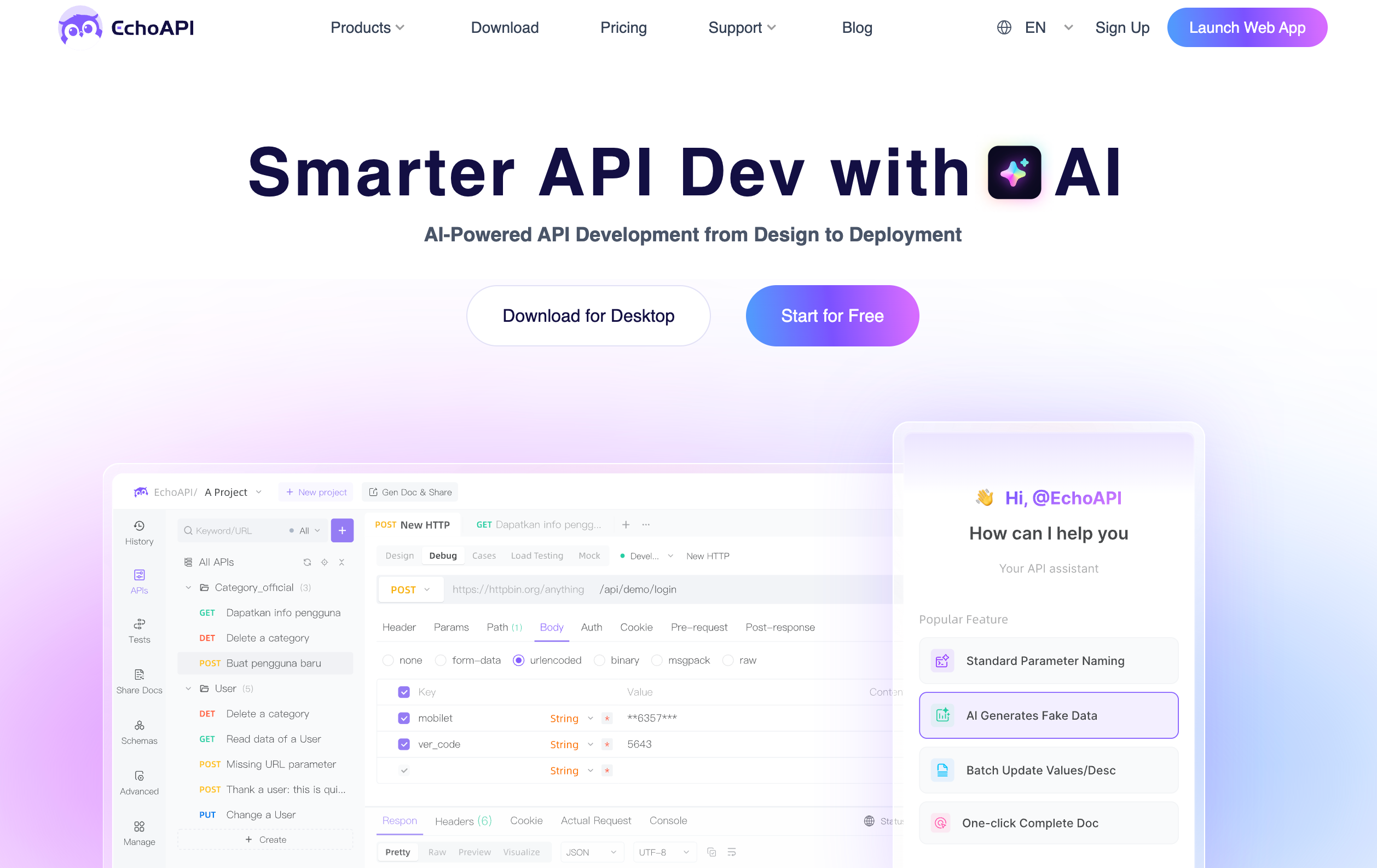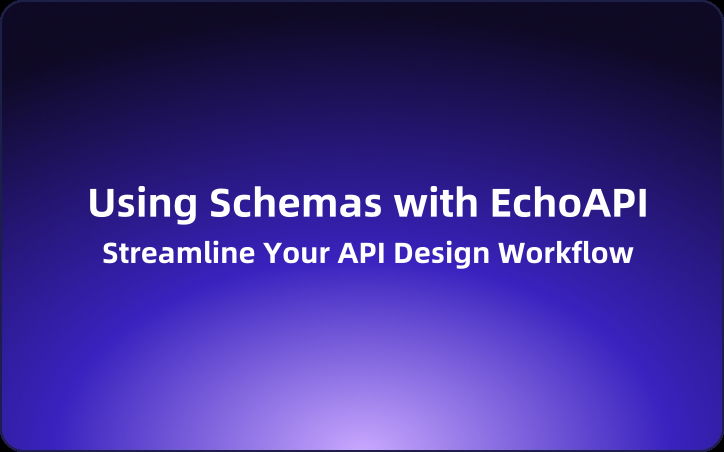Ultimate Guide to JSON API Design: Principles, Best Practices, and Schema Standards
This article offers a comprehensive guide to structured JSON design, covering principles, best practices, and schema standards, and shows how EchoAPI's schema modeling can help achieve standardized, automated, and intelligent data structure design.
In today's API-first software architecture, JSON has become one of the most widely used data exchange formats. Whether it's RESTful APIs, configuration files, database storage, or log analysis, JSON plays a foundational role.
However, through extensive real-world system practice, we’ve observed that chaotic JSON design, lack of standardization, and inconsistent interfaces are still widespread. These issues seriously impact system maintainability, front-end/back-end collaboration efficiency, and the evolvability of APIs.
This article systematically outlines the core knowledge of structured JSON design, analyzes common issues in depth, and introduces how to leverage EchoAPI’s Schema modeling capabilities to achieve standardized, automated, and intelligent data structure design.
Core Knowledge System of Structured JSON Design
1.1 Basic Structures and Data Types
JSON is composed of two fundamental structures:
| Type | Example | Description |
|---|---|---|
| Object | { "key": "value" } |
Unordered key-value pairs |
| Array | [1, 2, 3] |
Ordered collection |
Supported data types include:
- String:
"hello" - Number:
42,3.14 - Boolean:
true,false - Null:
null - Object
- Array
1.2 Common JSON Structural Patterns
Flat Structure
{
"id": 1,
"name": "Alice",
"email": "alice@example.com"
}
- ✅ Simple and ideal for basic objects
- ❗ Cannot express complex business semantics or relationships
Nested Structure
{
"user": {
"id": 1,
"profile": {
"name": "Alice",
"email": "alice@example.com"
}
}
}
- ✅ Reflects real-world object models
- ❗ Avoid excessive nesting ("Russian doll" structure)
Array of Objects
{
"users": [
{ "id": 1, "name": "Alice" },
{ "id": 2, "name": "Bob" }
]
}
- ✅ Common for representing lists
- ❗ Ensure consistency in array item structure
1.3 Design Principles and Common Issues
Consistency
Definition: Use consistent field names, hierarchy levels, and data types across interfaces.
❌ Incorrect Example:
// API A
{ "user_id": 101, "user_name": "Tom" }
// API B
{ "uid": 101, "name": "Tom" }
✅ Correct Example:
{ "user_id": 101, "user_name": "Tom" }
Recommendations:
- Define domain field standards (e.g., always use
user_id, notuid,id, oruserid). - Document naming conventions.
Readability
Definition: Use meaningful, clear field names. Avoid abbreviations or vague terms.
❌ Incorrect Example:
{ "u_n": "Alice", "t_c": "2025-07-09" }
✅ Correct Example:
{ "user_name": "Alice", "created_time": "2025-07-09T12:00:00Z" }
Recommendations:
- Use full words (e.g.,
emailinstead ofeml) - Maintain clarity in English for collaboration and documentation
- Adopt a shared naming dictionary (
created_at,status, etc.)
Orthogonality
Definition: Each field should serve a single, distinct purpose.
❌ Incorrect Example:
{ "user_info": "Tom,101,true" }
✅ Correct Example:
{
"user": {
"id": 101,
"name": "Tom",
"is_active": true
}
}
Recommendations:
- Do not combine multiple values into one string field
- Use nested structures to represent complex entities
Limit Nesting Depth
Definition: Keep nesting to 2–3 levels to maintain readability and performance.
❌ Incorrect Example:
{
"user": {
"profile": {
"meta": {
"settings": {
"preferences": {
"theme": "dark"
}
}
}
}
}
}
✅ Correct Example:
{
"user": {
"theme": "dark"
}
}
Recommendations:
- Restrict nesting to ≤3 levels
- Use references or separate models for complex structures
Extensibility
Definition: Enable easy addition of fields or substructures without breaking existing designs.
❌ Incorrect Flat Structure:
{
"user_name": "Alice",
"user_email": "alice@example.com",
"user_age": 25
}
✅ Correct Nested Structure:
{
"user": {
"profile": {
"name": "Alice",
"email": "alice@example.com",
"age": 25
}
}
}
Recommendations:
- Use nested modules (
profile,settings, etc.) - Design with future extensibility in mind
Minimal Redundancy
Definition: Avoid duplicating information unnecessarily.
❌ Incorrect Example:
{
"user_id": 101,
"user": {
"id": 101,
"name": "Alice"
}
}
✅ Correct Example:
{
"user": {
"id": 101,
"name": "Alice"
}
}
Recommendations:
- Eliminate redundant fields (especially IDs and statuses)
- Keep the payload concise and unambiguous
Type Clarity
Definition: A field's data type should be consistent across all contexts.
❌ Incorrect Example:
{ "status": 1 }
{ "status": "active" }
{ "status": { "code": 1, "text": "active" } }
✅ Correct Examples:
{ "status": "active" }
or
{ "status": { "code": 1, "label": "active" } }
Recommendations:
- Use fixed types (
string,object, etc.) - Prefer enums or structured objects for status fields
Summary
| Principle | Description |
|---|---|
| Consistency | Field naming, structure hierarchy, and data formats should be consistent across different APIs. |
| Readability | Field names should clearly express their meaning, helping developers understand their purpose intuitively. |
| Orthogonality | Each field should convey a single, unambiguous meaning; avoid combining multiple meanings in one field. |
| Limit Nesting Depth | Limit JSON nesting depth to improve readability, parsing performance, and frontend processing efficiency. |
| Extensibility | JSON structures should be designed for future extension, supporting version evolution. |
| Minimal Redundancy | Avoid duplicate or redundant fields to keep data structures clean and efficient. |
| Type Clarity | Ensure that field data types remain stable and consistent; avoid mixing or dynamically changing types. |
1.4 Naming Standards
| Item | Recommendation |
|---|---|
| Naming Style | Use snake_case (user_name) or camelCase (userName) |
| ID Fields | Use standardized names: id, user_id, order_id |
| Time Fields | Use ISO 8601: "2025-07-09T12:00:00Z" |
| Status Fields | Use semantic enums like "active", avoid 1 / 0 |
Best Practices for JSON Design
Type Clarity
❌ Incorrect:
{ "price": "123.45" }
✅ Correct:
{ "price": 123.45 }
Recommendations:
- Use
numberfor numeric fields - Use string (e.g., ISO 8601) for time fields consistently
Use Enums or Booleans for Status
❌ Incorrect:
{ "status": 1 }
✅ Correct (Boolean):
{ "is_active": true }
✅ Correct (Enum):
{ "status": "active" }
Standard Error Response Format
❌ Incorrect:
{ "error_msg": "Invalid email", "code": 400 }
✅ Correct:
{
"code": 400,
"message": "Invalid request parameter",
"error": {
"field": "email",
"reason": "Invalid format"
}
}
Use JSON Schema for Structure Definition
{
"type": "object",
"properties": {
"email": {
"type": "string",
"format": "email"
},
"age": {
"type": "integer",
"minimum": 0
}
},
"required": ["email"]
}
Benefits:
- Clear field constraints
- Automatic request/response validation
- Supports documentation and testing tools
Avoid Overuse of null
❌ Incorrect:
{ "nickname": null }
✅ Better:
{
// simply omit "nickname" if not provided
}
✅ Keep null only when needed:
{ "nickname": null } // Explicitly indicates user cleared the field
Summary
| Practice | Recommended Example |
|---|---|
| Type Clarity | Use price: number, not a string like "123.45". |
| Use Enums or Booleans for Status | Use status: "active" or is_active: true, instead of status: 1. |
| Standard Error Format | Use a standard error structure like { code, message, error }. |
| Define Structure with JSON Schema | Clearly specify field types, required fields, format constraints, etc. |
Avoid Overuse of null |
Omit fields with no value instead of returning "field": null, unless null is semantically meaningful. |
EchoAPI Schema: Unified JSON Modeling

1. Visual Schema Designer
- Add or edit fields visually, set types, descriptions, and required status
- Drag-and-drop to reorder fields
- Supports nested objects, arrays, and references
- Instantly preview both schema and example JSON
- Manage reusable models by category for easier maintenance
2. Import Various Structure Files
Easily convert existing data formats into fully usable schemas:
- ✅ JSON examples
- ✅ JSON Schema
- ✅ XML
- ✅ MySQL DDL
This dramatically accelerates schema creation—especially helpful when onboarding legacy APIs or databases.
3. AI-Assisted Schema Completion
| Feature | Description |
|---|---|
| Intelligent Field Descriptions | Auto-generate readable labels for better clarity |
| Type and Example Inference | Recommends field types, sample values, and defaults |
| Model Reference Completion | Reuse and sync definitions from existing models |
| Schema Rule Auto-fill | Automatically adds required, enum, format, etc. |
Save time and reduce manual errors with smart suggestions based on content and context.
4. Export & Standards Compatibility
EchoAPI is built with interoperability in mind:
- ✅ Export to OpenAPI 3.0
- ✅ Supports Swagger Editor for live preview
- ✅ Advanced JSON Schema support (
anyOf,oneOf,$ref, etc.) - ✅ One-click export of mock data, API documentation, and SDKs
5. Boost Frontend–Backend Alignment
Unified schemas ensure consistent expectations between frontend and backend developers, making integration smoother and reducing miscommunication.
6. Validate and Enforce Data Structure
Schemas in EchoAPI enforce field types, required rules, and value constraints—reducing bugs and increasing confidence in API stability.
7. High Reusability and Modularity
Extract shared structures as standalone schemas and reference them across multiple endpoints—promoting DRY principles and easier updates.
8. Flexible Field-Level Customization
Control validations like:
- Array length limits
- String
minLength/maxLength - Number ranges
- Enum sets, patterns, formats
9. Live Preview & Code Mode
Switch between visual editing and raw JSON Schema code for full flexibility—perfect for both beginners and power users.
10. Cross-Platform Toolchain Integration
EchoAPI supports:
- IntelliJ IDEA plugin
- VS Code plugin
- Chrome request capture extension
All without requiring a login. Lightweight, fast, and developer-friendly.
EchoAPI streamlines schema design with intelligent tools, visual editing, smart imports, and full standards support—making your API workflow faster, more consistent, and easier to maintain.



Final Thoughts: Structure is Contract, Schema is Language
APIs are the language of interconnected systems, and JSON is their syntax. With EchoAPI, your team can:
- Minimize risk from structure changes
- Avoid miscommunication
- Accelerate front-end/back-end collaboration
- Keep documentation and code in sync
- Build a unified data structure standard
If you're designing complex APIs or aiming for more robust, intelligent JSON structures — EchoAPI Schema is worth a try.




 EchoAPI for VS Code
EchoAPI for VS Code

 EchoAPI for IntelliJ IDEA
EchoAPI for IntelliJ IDEA

 EchoAPl-Interceptor
EchoAPl-Interceptor

 EchoAPl CLI
EchoAPl CLI
 EchoAPI Client
EchoAPI Client API Design
API Design
 API Debug
API Debug
 API Documentation
API Documentation
 Mock Server
Mock Server









